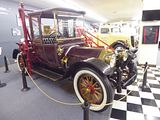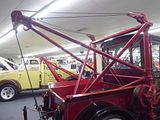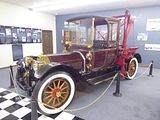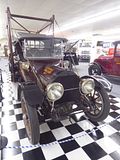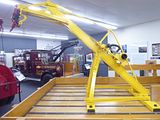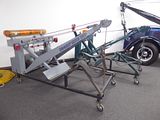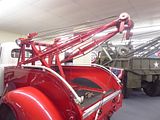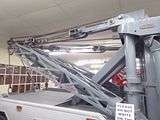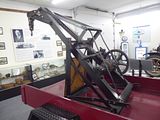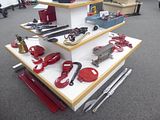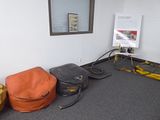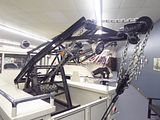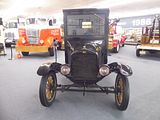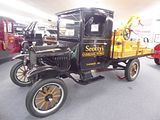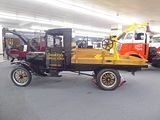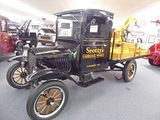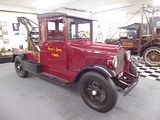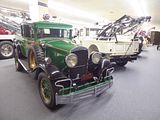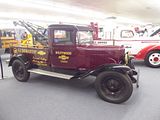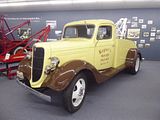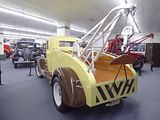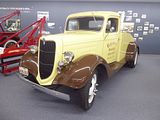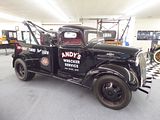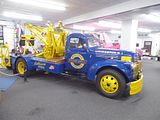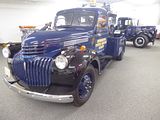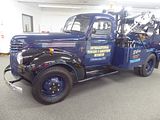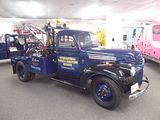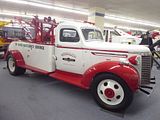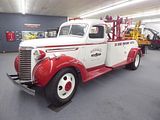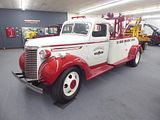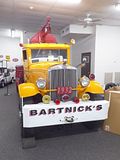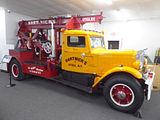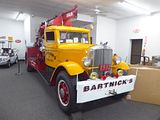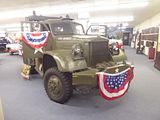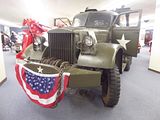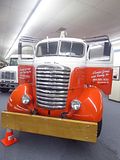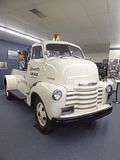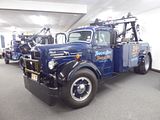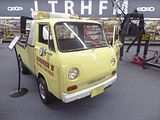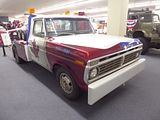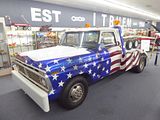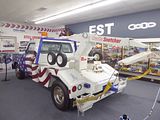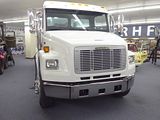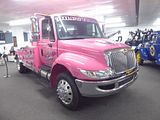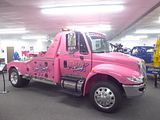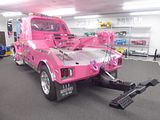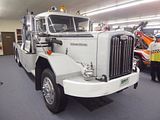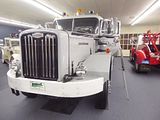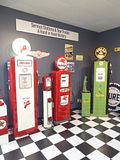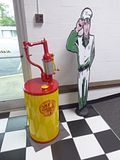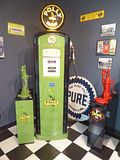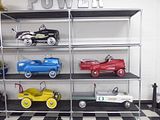When I was planning my short trip to some of the USA’s Southern States, and visits to a couple of world renowned car museums, reports on which I have already posted, I needed to break up the journey north from Atlanta, and chose to overnight in Chattanooga, just over the Georgia State border in Tennessee. This provincial city is perhaps best known for its eponymous train, the Chattanooga Choo Choo, made popular in a Glen Miller song of 1941, though in fact the name goes back to the 19th century at a time when the rail network was still being built and a line from St Louis, Missouri connected up with the east-west line in this city which had seen some serious military action in the wars of independence some years earlier. These days, car enthusiasts may also know it as the location that VW chose to build their US factory, which is still in operation producing cars such as the US market Passat. It’s an interesting place, and has a couple of car-related museums, as I found out when I arrived in the city, and spotted an advert for one of them, the Coker Museum on the bottom of the city map that I picked up. More research revealed that there was a second museum for the automotive fan, and I resolved to pay that one a visit on my return trip south when I would once again be staying the area. So here it is, the International Towing and Recovery Museum.
It all started more than 37 years ago when a group of dedicated towing professionals, the Friends of Towing, decided to recognize outstanding individuals in the towing and recovery industry worldwide, record the industry’s history, collect and display artifacts and memorabilia in a museum setting, and provide information about the industry to the public. The first Hall of Fame class consisted of 27 members and today has grown to include over 300 distinguished towing professionals. In its humble beginnings, the Friends of Towing displayed the Hall of Fame and Museum in a semi-trailer and drove it to and from towing and recovery industry trade shows across the country. In 1995, when it came time to settle down in one permanent location, the organization decided on the scenic city of Chattanooga, TN. Chattanooga had been credited as the birthplace of the tow truck thanks to inventor Ernest Holmes Sr. Holmes and his son Ernest Holmes Jr. would go on to establish a major towing manufacturer named the Ernest Holmes Company. Today the museum has evolved from the Friends of Towing into the International Towing and Recovery Hall of Fame and Museum. In 2006, the museum dedicated a memorial, The Wall of the Fallen, in honour of men and women who lost their lives in the line of service. In 2007, at the first Wall of the Fallen dedication service, 94 names were added to the wall. Since its establishment, the names of towing operators who have lost their lives are added during a special ceremony in September. The museum moved to its current site in 2003 and is located on the outskirts of the city
Ernest Holmes Sr. is credited with inventing the first U.S. tow truck. His idea resulted from being one of a group of friends who struggled to hours to retrieve a Model T out of the Chickamauga Creek. Holmes modified a 1913 Cadillac to pull cars and transport them to his garage by affixing an iron chain, a pulley and several poles to the back of his Cadillac. Holmes quickly patented his invention, and thus the U.S. towing industry was born. He spent the next two years theorizing and forming a concrete idea, filing his patent on January 17, 1918. The basis for Ernest Holmes Sr.’s patents was the unique concept of having a “split-boom” wrecker that could anchor the truck on one side and retrieve from the other side without tilting the wrecker. This was especially useful when a wrecked vehicle was down a steep embankment.
1913 Cadillac: On loan from the Pellow Family, this 1913 Cadillac with a 1916 Holmes 680 is a replica of the first tow truck ever produced. This Cadillac was found in the late 1950s and taken to the Holmes factory in Chattanooga. The wrecker was fitted with an original antique wrecker setup and restored as a replica of the original tow truck. By 1990, the truck was purchased by the Pellow’s family in Minnesota and restored to what is currently on display. This model of Cadillac was typically equipped with a 4-cylinder, 30 Horsepower unit, with both magneto and battery distributors. The system was called the Holmes 680 as it cost $680.
Holmes’ original system is also shown here on this 1913 Locomobile-based truck. The Locomobile was built in Bridgeport, CT and features a 6 cylinder engine which generates 82 bhp. Note the wooden wheels and brass lights, very much of the period. This truck has the Holmes 485 system mounted on it. This was rated at 4 tons, 2 tons per side and was hand operated. Both booms could swing out and there are outriggers to ensure stability of the truck whilst it was making a recovery.
Holmes’ system continued to evolve with a smaller and cheaper towing system emerging, which was called the 485, as it cost $485. Holmes would go on to develop his towing systems but it was not long before competing solutions emerged. Other notable contributors to the industry were Oscar Hubbard and the Manley Division of the American Chain and Cable Company. Some Manley equipment is thought to have been built as early as 1915 but there is no conclusive evidence.
After his death in 1945, Holmes was succeeded by his son, Ernest Holmes Jr., who took over the company and continued growing what his father had started. Holmes wreckers began aiding NASCAR, removing damaged cars from the track, and by the mid-1960s, the majority of wreckers in the industry were Holmes units. Holmes’ grandsons, Gerald Holmes and Bill Holmes, founded Century Wrecker Corp. in 1974, which produced hydraulic towing equipment that’s now used universally in the industry. Miller Industries acquired both Holmes and Century in 1990 and has achieved large-scale success selling these product lines, along with other brands. Today, Miller operates a plant outside of Chattanooga in Ooltewah and stands as a world leader in the towing and recovery industry, with manufacturing plants in three countries.
Lots of side displays provide information on other developments that came about in the industry to make the job of recovering vehicles easier, cheaper and safer. As well as a vast array of tow hooks these also included an explanation of the benefits of the Air Cushion, which was invented in the early 1970s as an innovative way of raising cars up to make it easier to recover them.
1929 Packard Model 640 with 3 Ton Manley Crane: In the early years of the wrecking industry, it was common to convert old limousines into wreck trucks by retaining the front part of the body and creating a new back end platform on which the recovery system could be installed. The reason for this is that large limousines tended to have much sturdier chassis and relatively potent engines, aming them better suited for the task in hand. This 1929 Packard Model 640 is a good example.
The Ford Model T and TT were popular vehicles to use for tow trucks. This is a 1926 TT with a Manley Crane system.
Also dating from 1926 is this Graham Brothers conversion, also with a 3 ton Manley crane. This truck was originally owned by a towing company in Cleveland, Ohio. When it was placed up for sale in a towing magazine, it was purchased by Wally Shriner and his son James, who drove it to Columbus Ohio. Since that time, it has been used exclusively for shows and parades before bening brought to the museum here. It is believed to be unique.
Chrysler never produced a purchasable pickup truck for service. This 1929 began life as a five window two-door coupe that had a standard 6-cylinder engine and a rumble seat. The rear end of the vehicle was replaced with a small bed and Fargo truck rear axle. This allowed the vehicle to operate as a truck and granted the vehicle the capability to tow with a Weaver Crane. It was in use by a dealership in Chicago for about 40 years. When the dealership closed, Jack Gratzianna bought the vehicle and restored it for use once more. Gratzianna, his family, and this truck were featured on Wrecked: Life in the Crash Lane, a short lived reality show on the Speed Channel (now Fox Sports 1). This has been donated by O’Hare Towing.
1929 Chevrolet with Manley Crane
As the towing industry developed, in parallel with the automotive sector, so it became more common to install the recovery systems on the back of trucks and lorries rather than converted old cars and the remainder of the 24 tow trucks on display in the museum showcase some lovely examples from the 1930s to more recent times, all beautifully restored and in period liveries.
This 1935 Ford 1 Ton pickup has a 1 1/2 ton Weaver crane installed in the bed of the truck. This truck began life as a standard Ford Model 50 1-ton pickup truck. This year was a pinnacle year for Ford as it introduced the infamous Flathead V8 engine. The engine would become one of the most famed engines produced by Ford in the 1930s. For this truck the bed was removed and replaced by a Ford Service Body Model 229 as was mounted in its place.
There were several more Chevrolet based vehicles on display including this 3-ton ’37 Chevy wrecker, and three more Chevrolets from the remainder of the decade.
Final pre-war Chevrolet is this 1940 truck with a Holmes 515 Crane on the back. This particular Holmes 515 was originally mounted on a 1949 Ford truck but it was too far damaged and deteriorated for restoration, so the unit was disassembled and then mounted on this Chevrolet. This 1940 Chverolet was originally a stake truck used for hauling cattle.
This one is based on a 1932 Mack.
The Holmes WD45 military wrecker, built on a Diamond T chassis, was built by the Holmes company in Chattanooga between 1941 and 1949. A total of 7223 were built, this one being constructed in 1943. These vehicles were deployed to the French fields of battle during World War II. It was part of the “Red Ball Express”, the Army truck line that delivered critical supplies to the Allies on the front lines. After a few years in service, it was sold to the French Army in 1947, then came up for auction in Metz in 1973. It was bought in 1980 by a Mr Becker, a collector in Luxembourg. Due to a lack of storage space, he sold it to Nicolas George, of Jige International, a manufacturer of towing equipment in France. The truck returned to the US in 1997 and has been on display in the museum ever since.
This is a ’47 GMC Bubble Nose that was first used to haul beer for the Pabst Brewing Company before it was converted to a wrecker to retrieve school buses and then abandoned in the countryside of Wisconsin because a replacement water pump could not be found. It took two years of dedicated searching during the restoration of this Bubble Nose to finally find a replacement water pump.
’48 Chevrolet COE truck chassis with a Holmes 515 on the back
’52 Ford F6 with a Holmes 460 box on the back
1950 Mack A Model: Mack had several models of very popular work trucks throughout its lifespan. One of the most popular models was the B Model Mack which were produced from 1953 to 1966. This truck is the predecessor model to the B Model, the A Model. The A Model had a lifespan from 1950 until 1953 and served as the “learning curve” for Mack to work out the issues with the truck to produce the superior B Model. Despite it being a precursor model, the truck still had significant power and appeal as a great work truck. This truck is equipped with a 291 cubic inch Magnadyne L-Head 6-cylinder engine. The engine provided roughly 100 to 120 horsepower. This Mack is equipped with the Holmes W-45 wrecker boom which saw production from 1941 to 1947.
The smallest truck here, by some margin is this Japanese 1970 Cony, which has a 2 cylinder engine. The body was modelled after the style of the Holmes Commander 1200. The wrecker boom was modelled after the Century body and the light was designed after the Challenger light pylon.
Dating from 1974 is this Ford F-150 with a Vulcan Cradle Snatcher rig on the back. This was originally owned by Bob London’s wrecking business in Longview, Texas and was traded out for a Vulcan Model 869 in 1989. Brent Mournahan of Vulcan Equipment then spent three days getting the truck back to the Vulcan plant at Olive Branch, Mississippi. It took a long time with a lot of stops as the truck averages around 4 mpg (!). In 1993 it was given this striking paint finish by “Hot Rod” Rod Mackenzie, with the US flag and the Canadian one on the other side. This seems appropriate since the truck was originally built at Ford’s plant in Toronto.
This Freightliner dates from 1995 and has a prototype Jerr-Dan composite structure on the back, which was designed to be able to recover and tow 25 tons.
This is a 2002 International H Truck with a custom Bill Bottoms Bed. The truck is equipped with a DT466 inline 6-cylinder turbo-diesel rated at a max of 350 horsepower. The truck was created to honour the wife of the owner Jerry Dale after her battle with cancer and others who lost the battle with cancer. The truck has been an attendee of multiple Tow Shows throughout the Ohio, Pennsylvania, Baltimore and West Virginia. This truck has been a show truck in parades and truck contests as well. This 2002 International has never towed a single vehicle but was built for show only. Though the truck is fully equipped to tow, it has never seen service.
Dating from 1962, this Autocar-Diesel with a 1953 Holmes W-70 crane, known affectionately as “Dad”, is the world’s largest mechanical wrecker. The base truck was originally designed for the military, but for some reason it didn’t meet their expectations, so production on this vehicle stopped after 4 were made. It uses a Cummins diesel with 5 forward gears and 4 auxiliary ones. The H-70 crane is the first chain-driven power-operated PTO for the boom, swing and extension. It is all original apart from the 4 boom legs, though the rest of the vehicle has been restored, back to its original and rather basic spec.
This Chevrolet Silverado based wrecker is the world’s fastest. It averaged 109 mph and reached 130 mph on the straightaways at Talladega Superspeedway in 1979. The speed run had to be stopped because the tyres were melting off the wheels.
There are lots of additional displays around the museum which are equally fascinating.
For starters there are numerous examples of historic petrol pumps showing the evolution of these once “pumping your gas” became a thing as opposed to buying fuel in glass jars from the local chemist.
One whole cabinet is dedicated to children’s Pedal Cars, showing that some of these once popular toys came in Wreck Truck guise.
Models of tow trucks fill several cabinets that line one complete wall of the museum, with a vast range on display, from familiar Corgi, Dinky and Matchbox toys that many will remember from their youth to items that are far rarer or more unusual including several hand-carved wooden models.
More details can be found on the museum’s own website: https://towingmuseum.com/



